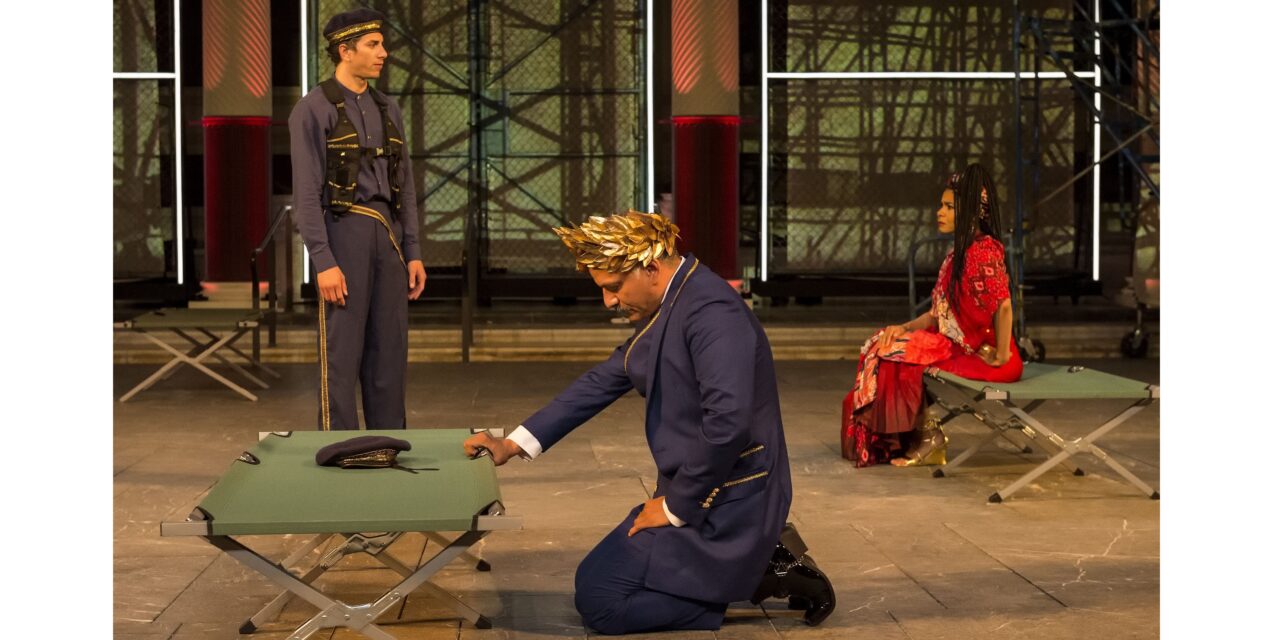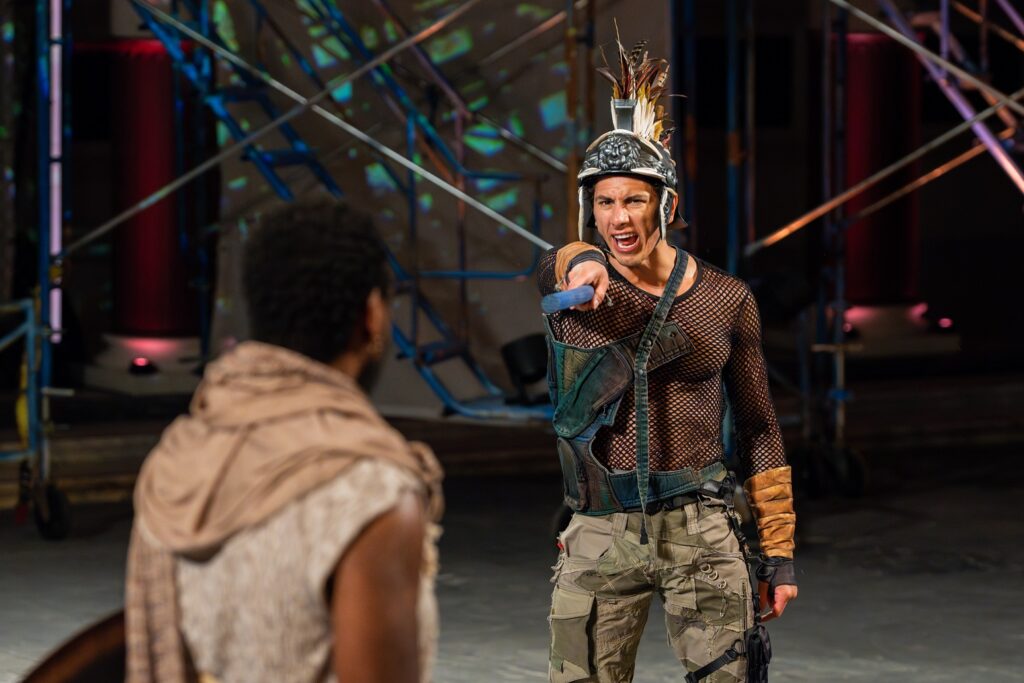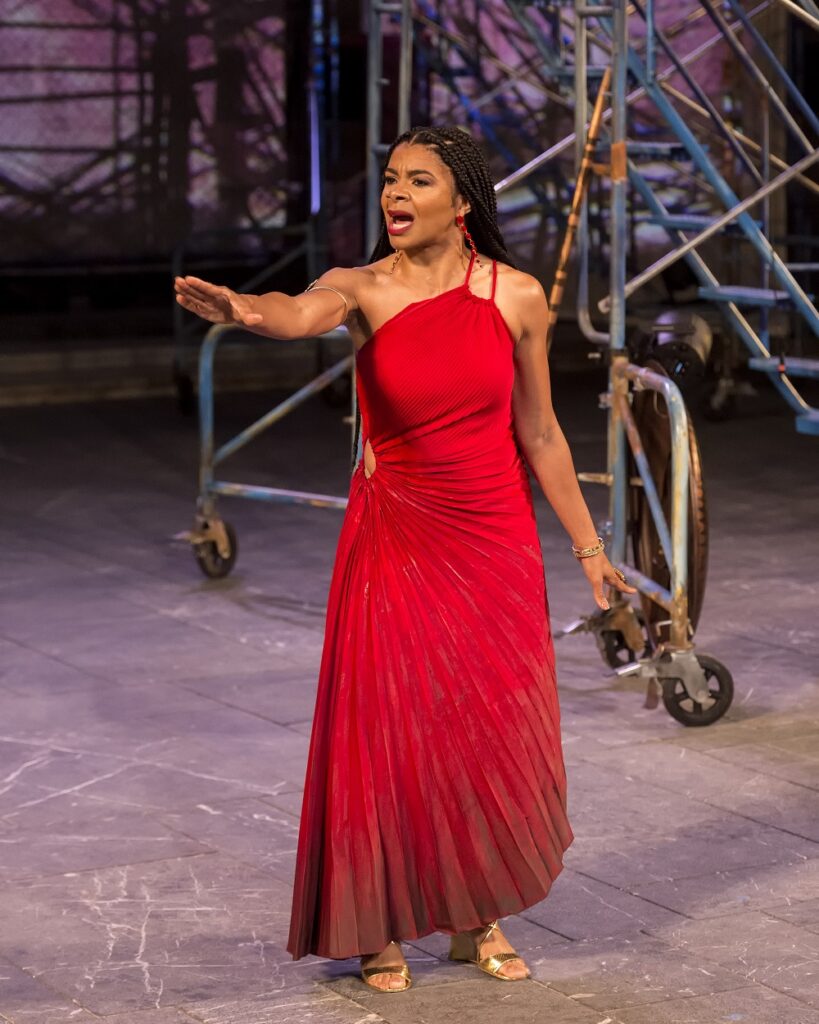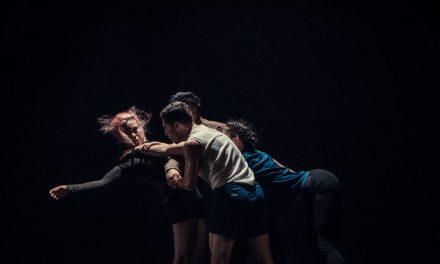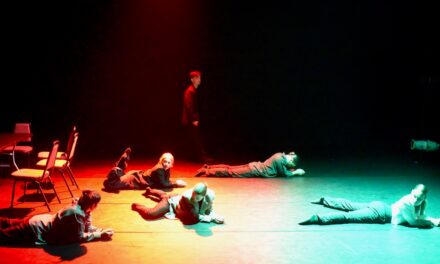There existed one Arctinus of Miletus who wrote the “Aethiopis,” the story of the exploits and life of Memnon, son of Tithonus and Eos (Dawn) and who became the king of the Ethiopians. This is a lesser known story precisely because it was lost through the ages and only mentioned by other writers. He is mentioned in the Odyssey of Homer. Tithonus was a son of Laomedon, King of Troy and brother to Priam, making Memnon a nephew to King Priam. It is after Hector has been killed by Achilles that Priam sends to his nephew in Aethiopia to come to his aid against the Greeks. Spoiler alert! I will be mentioning some events that happen during this show. I do not believe it will ruin any part of this spectacular tale, however.
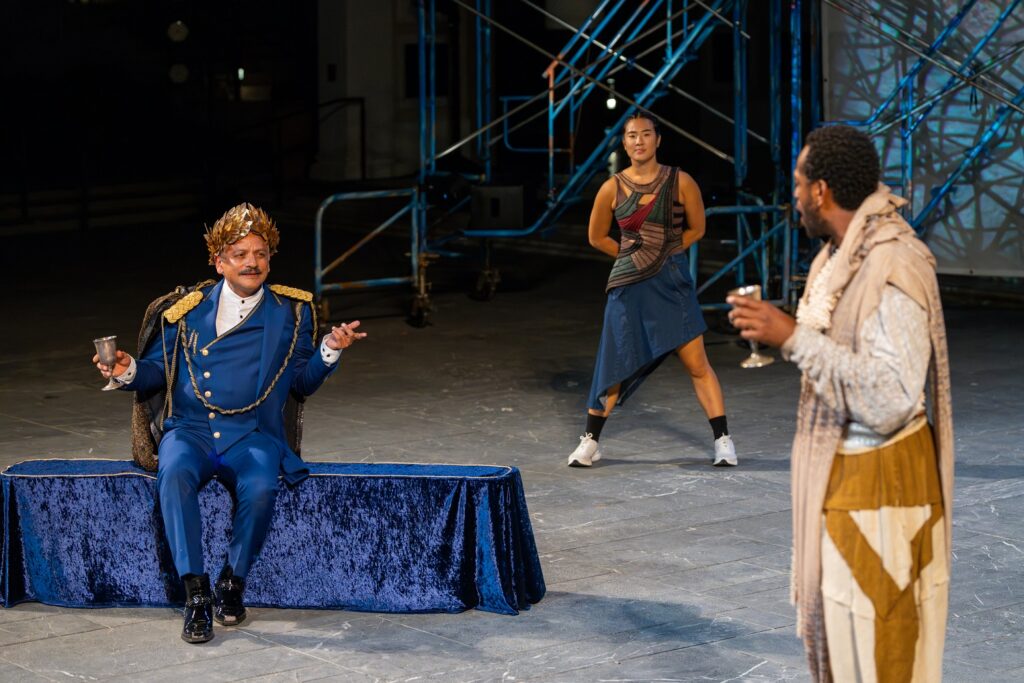
Jesse J. Perez as Priam and Eric Berryman as Memnon in foreground, and Holly Hwang Belshaw as Chorus in background. Photo: © 2024 J. Paul Getty Trust.
The Classical Theatre of Harlem has created an engaging narrative of this hero’s part in the Trojan War. Written by Will Power and directed by Carl Cofield and conceived by both, this is a riveting and compelling addendum to Homer’s Iliad. Memnon is a character from mythology/history that has gone unremembered and unsung too long. Like Joseph Bologne, Chevalier de Saint-Georges, Memnon was fully celebrated for his exploits and heroic deeds. Yet his life and character have been lost to history, his place in the events leading to the destruction of Ilios buried in time. There are snippets of his part in the family of Troy extant and we are thankful for that after witnessing the glorious production presented at the Getty Villa.
This was the 18th annual production presented by Ralph Flores at the Getty Villa as part of their outdoor theater series and unusual in that it is an original, world premiere work. As stated in the program notes for the show, “In classical mythology, Memnon was a revered figure, inspiring great works of literature and art. The story of this African hero provides crucial insight into the worldview of the ancients, demonstrating the cultural and racial diversity of their societies. In today’s very divided social landscape, the story of Memnon needs to be better known and understood” (Timothy Potts).
The playwright Will Power has created a new play, based on the attributes of the ancient writers. It is in keeping with the language and style of other Greek originals and embodies that power of storytelling. It is written in iambic hexameter which is, “as close as I could come to the original meter of classical Greek drama (dactyl hexameter)” (Will Power). He goes on to outline different qualities of Memnon and how important they were to the ancients. Memnon was as fierce and powerful as Achilles and their meeting on the battlefield outside Troy was legendary for its ferocity and display of strength. Both Aeschylus and Sophocles had plays that related his adventures. And he was an African King heralded by the Greeks.
There was a lot going on in this play. The themes interwoven throughout were both timely and ancient, although easily understandable to the theater goer of today. There is Memnon’s duty to his Uncle and his family at Troy under siege by the Achaeans, there is the reason why he left Troy to become King in Ethiopia due to an inequality foisted upon him by Priam. There are his uneasy feelings towards taking part in a war that is not his. There is his natural inclination to not kill everyone in his path, but to find a solution to conflict that does not decimate the population. There is his guilt at leaving Troy and his anger at having no choice. There is also the uncomfortable feeling at having been dislocated from one’s own homeland and yet not entirely belonging to one’s adopted land. A feeling shared by both Memnon and Helen and not unknown to millions of African-Americans I am sure. The direction by Carl Cofield brought all of this to bear on the action and fulfilled the stylization of Greek drama beautifully.
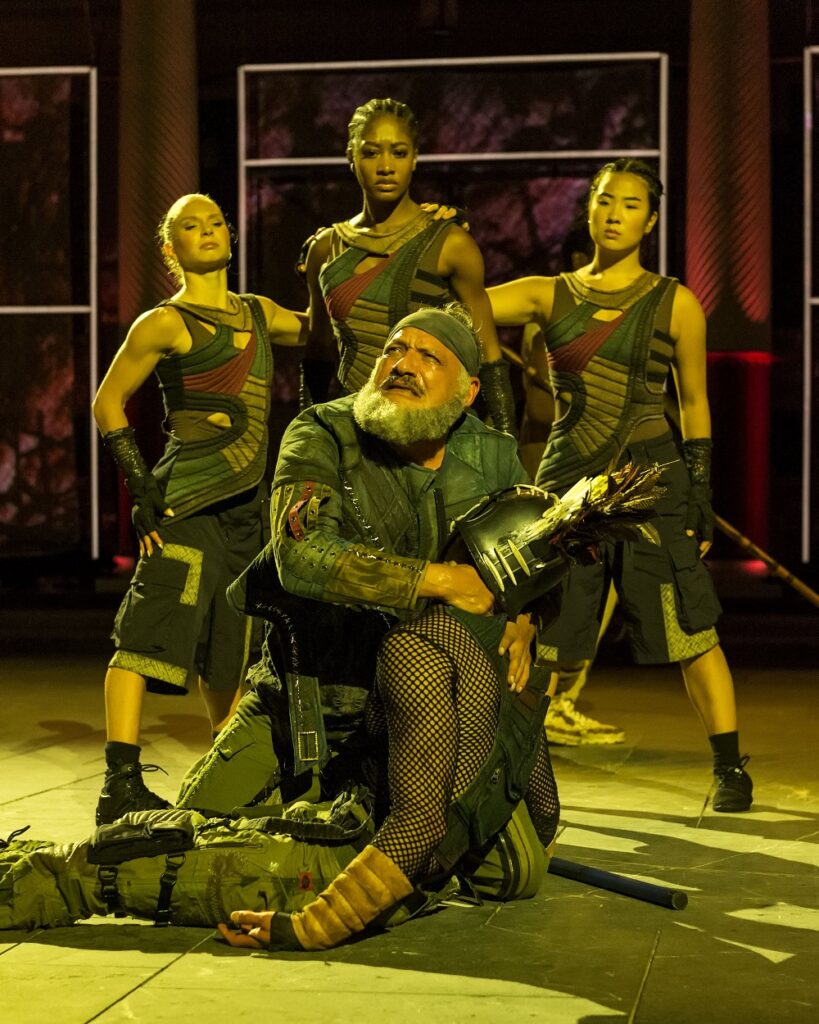
Jesse J, Perez as Nestor, Daniel José Molina as Antilochus, Katherine (Kat) Files, Jenna Kulacz, and Holly Hwang Belshaw as Chorus – Photo: © Craig Schwartz Photography.
The choreographer for Memnon is Tiffany Rea-Fisher, artistic director of the modern dance company EMERGE125. She has three of her dancers represent the chorus in Memnon, Holly Hwang Belshaw, Katherine Files, and Fana Minea Tesfagiorgis. Unfortunately, much of the movement for the chorus was superfluous to the arc of the play. The three dancers were obviously excellent and capable, but their movement was not as powerful or compelling as the individual actors. They had some physical commentary towards a number of the scenes but too often they were peripheral and not necessary for the forward projection of the themes of the play. They had gestures and some telling unison movement but it was often lost in the expanse of stage and under the moon and stars of the open amphitheater of the Getty Villa. They were only three opposite the main characters who have a great deal of text and movement of their own. Our attention was on the main characters. I wonder if it would not have been better to have them embody the three Fates to comment on the action of Memnon’s life rather than three silent chorus. Greek Chorus usually has commentary on the action and characters in the play.
The set designed by Riw Rakkulchon was strong and served the text well as there were two scaffolding structures downstage which served as the walls of Troy and two three-story scaffolding structures upstage left and right which were not utilized at all. This seemed an oversight. Costume design by Celeste Jennings was fantastic. The details of the military uniforms cut on the bias were elegant and sharp. Helen’s dresses flowed with an easy comfort suggesting the climate of Troy. Memnon’s uniform expressed a desert nomad while his shield was articulate. All of it helping to define the characters.
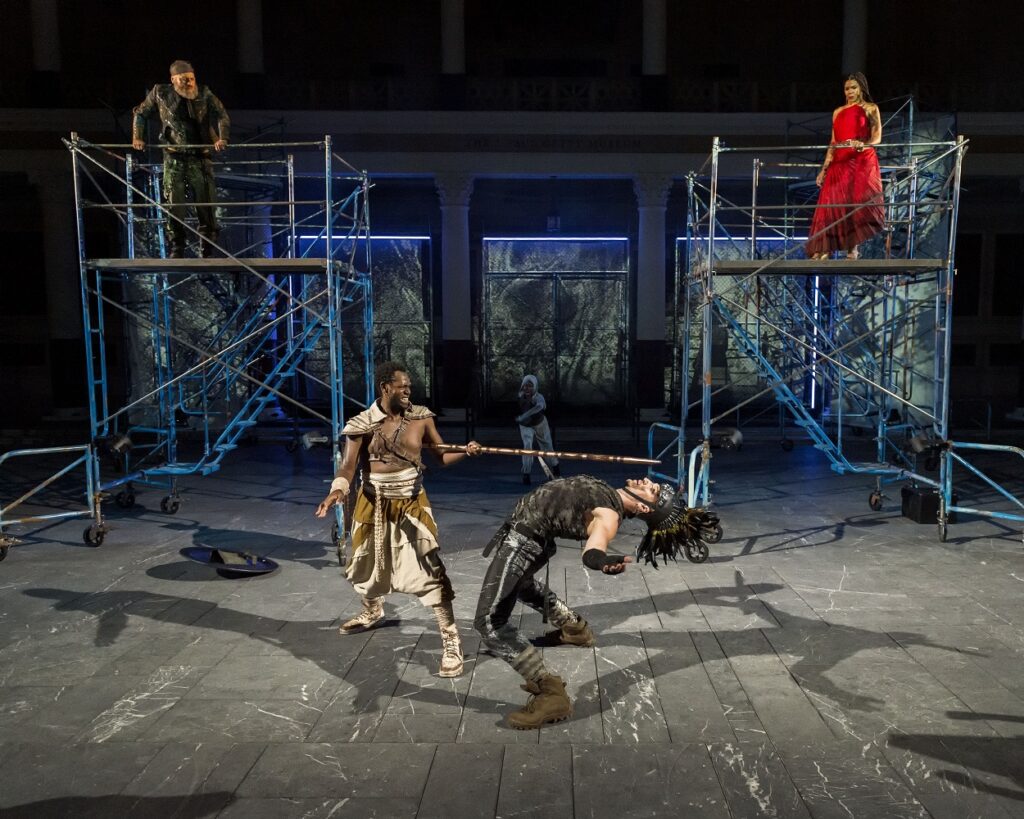
Eric Berryman as Memnon and Jesse Corbin as Achilles in the foreground with Jesse J. Perez as Nestor and Andrea Patterson as Helen in the background – Photo: © Craig Schwartz Photography.
Eric Berryman as Memnon was strong, intelligent, calculated and honest. Truly a foil for Achilles and one of the most honorable warriors of the Trojan War. Andrea Patterson was believable as Helen and delivered her impossible position with insight and subtle emotion. Jesse J. Perez had the dual roles of Priam and Nestor and managed to differently shade both with their prospective goals and desires, fears and faults. Daniel José Molina showed us first Polydamas and then Antilochus separating the two beautifully. His diction was excellent and very much appreciated by this reviewer. Jesse Corbin played Achilles and was laudable in the role. His commitment to the Achaeans was ever wavering and his sensibilities often overcame his judgement, just like in the “Iliad.” Obviously, Achilles is often portrayed as physically commanding, huge in muscle and stature, and this was certainly the case with Corbin. When given the choice whether to die young and famous or to die old and anonymous, Achilles chooses the former. Later in the underworld we are told that he regrets this choice. This is our clue as to how deep a thinker and ponderer of action Achilles is. Well-portrayed by Corbin in all aspects. It was a very tight and well-presented show which moves along at a snappy pace.
For more information about The Classical Theatre of Harlem, please visit their website.
For more information about The Getty Villa Museum, please visit their website.
Written by Brian Fretté for LA Dance Chronicle.
Featured image: Jesse J. Perez as Priam in foreground, Daniel José Molina as Polydamas and Andrea Patterson as Helen in background – Photo: © Craig Schwartz Photography.

